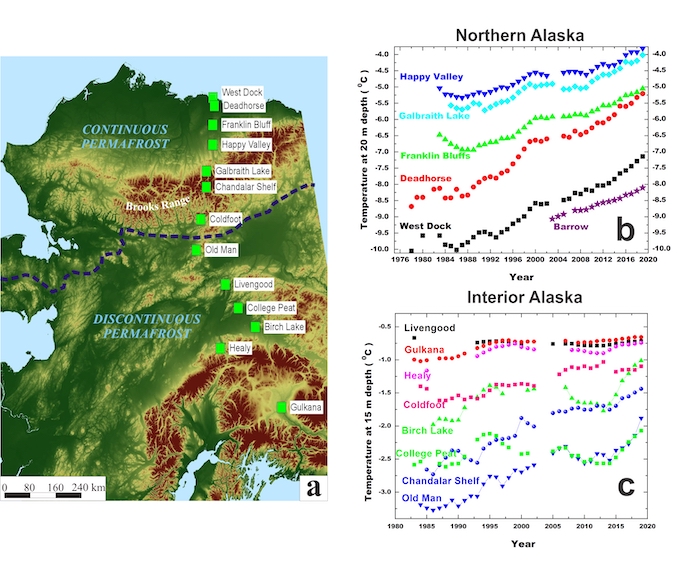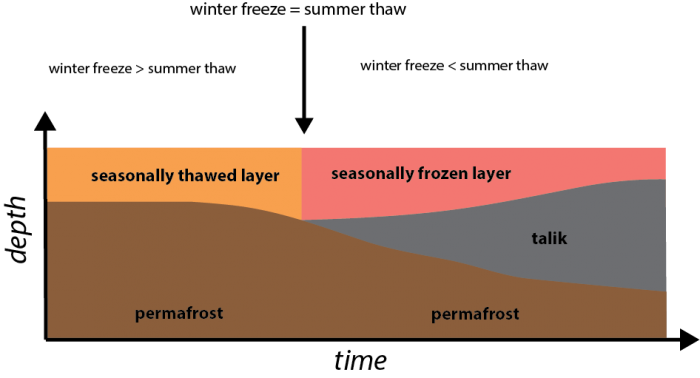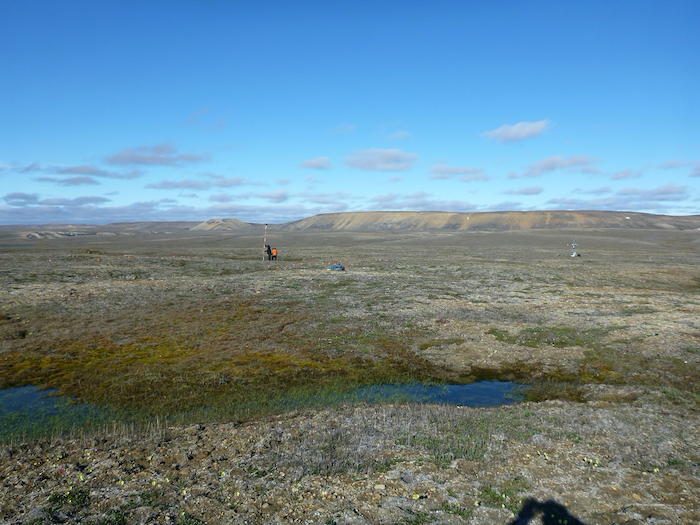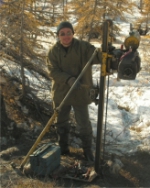By: Louise Farquharson, Postdoctoral Researcher; Vladimir Romanovsky, Professor of Geophysics; Dmitry Nicolsky, Research Professional; and Alexander Kholodov, Research Associate; Geophysical Institute Permafrost Laboratory, University of Alaska Fairbanks
Permafrost underlies approximately 24 % of northern hemisphere terrain (Brown et al., 1997) where landscape stability relies on a critical geomorphological threshold of 0°C. Monitoring the rate and magnitude of permafrost warming is critical to understanding future landscape response to ongoing warming and the potential implications for both the built and natural environment. The University of Alaska Geophysical Institute Permafrost Laboratory manages an extensive network of permafrost monitoring sites across Alaska, Canada and Siberia. For 15 years the monitoring effort has been funded primarily by the National Science Foundation (NSF) Office of Polar Programs (OPP), with supplemental funding from the Department of Energy (DOE) Next Generation Ecosystem Experiment (NGEE) and National Aeronautics and Space Administration (NASA). Long-term monitoring sites provide important baseline data that enable us to explore how ground temperature responds to ongoing climate change. By comparing recent changes in ground temperature with long-term trends we are able to identify novel changes in ground thermal regime that differ to historical norms.

Permafrost temperature changes are driven primarily by fluctuations in air temperature but local factors also play an important role. These include the variations in snow cover, thermal properties of soil, soil moisture content, and overlying vegetation. Monitoring can provide insight into how air temperature change combined with variations in the aforementioned environmental factors interact to influence permafrost temperature.
In recent years, long-term monitoring has enabled us to observe several changes in ground thermal regime and landscape stability. In Alaska ground temperature is warming most rapidly in northern regions characterized by continuous permafrost, where since the early 1990s ground temperature has increased on average by 1°C per decade, or 0.1°C per year (See Figure 1b). Within the discontinuous zone of Interior Alaska, ground temperatures are warming more slowly, due to latent heat effects related to the melting of ground ice (See Figure 1c) (Nicolsky and Romanovsky, 2018; Romanovsky et al., 2019). Moreover, permafrost temperatures in the Alaskan Interior started to experience a slight cooling in the late 1990s that has continued through the first half of the 2010s. The warming resumed in the mid-2010s. By 2019, new record highs for the entire period of temperature measurements at depth of 15 meters were recorded at all locations in the Interior. Long-term monitoring within the discontinuous permafrost zone has also enabled us to identify sites that have, until recently, completely frozen by the end of the winter but which are now experiencing incomplete refreezing. At several sites a combination of deep summer thaw, warmer than normal winters, and heavy snow fall has led to the summer thaw depth exceeding the depth of winter freezing. During the winters of 2017-2018 and 2018-2019 we observed novel incomplete refreezing at approximately 20 sites, primarily in the Fairbanks and Nome regions. As temperatures continue to warm, this process will eventually lead to the formation of a talik—a permanently thawed layer between the seasonally frozen layer (formerly the active layer)—and the top of the permafrost. (See Figure 2) While the pattern of incomplete refreeze is currently dependent on an early and thick snow pack, a combination of permafrost modelling, observations, and climate projections under the Intergovernmental Panel on Climate Change (IPCC) scenario 8.5 suggest that incomplete refreeze and talik development may become permanent at these sites regardless of snow conditions by the mid 2030's.

Warming ground temperature has also led to changes in surface topography. At three observation sites in the Canadian high-Arctic archipelago: Banks Island, Prince Patrick Island, and Ellef Ringnes Island, we observed rapid thermokarst development between 2006 and 2016 (Farquharson et al., 2019). Thermokarst development was caused by several summers that were twice as warm as were historically normal. The presence of only a thin layer of organic material at the ground surface meant that the underlying ground was poorly buffered against short periods of warmer than normal summer temperatures, resulting in rapid active layer deepening and melt of near surface ground ice. Between 2006 and 2016 the ground surface at all three sites was transformed from flat to thermokarst affected terrain (See Figure 3). At our two northernmost sites on Prince Patrick Island and Ellef Ringnes Island, we observed subsidence of up to about 1 meter and the formation of new thaw ponds across the landscape (Farquharson et al., 2019). Our observations join those of Canadian researchers who have also observed a rapid increase in thaw slump activity both on Banks Island, and Ellesmere Island 1,000 km to the north (Lewkowicz and Way, 2019; Ward Jones et al., 2019). Such changes are likely to have long term implications for vegetation, hydrology, and sediment transport.

As air temperatures in the Arctic continue to warm, ongoing monitoring will be critical in understanding the response of permafrost terrain which in turn has implications for both the built and natural environment. As we enter into our third funding phase under NSF'S Arctic Observation Network (AON) program, we intend to continue monitoring ground temperature across our established network. We will also begin to compliment ground temperature measurements with high-temporal resolution geomorphological surveys that will enable us to correlate increases in ground temperature with subsequent changes at the surface, in the form of thermokarst and surface lowering.
References
Brown, J., O.J. Ferrians Jr., J.A. Heginbottom, E.S. Melnikov. 1997. Circum-Arctic map of permafrost and ground-ice conditions. US Geological Survey Reston.
Farquharson, L.M., V.E. Romanovsky, W.L. Cable, D.A. Walker, S.V. Kokelj, D. Nicolsky. 2019. Climate Change Drives Widespread and Rapid Thermokarst Development in Very Cold Permafrost in the Canadian High Arctic. Geophys. Res. Lett. https://doi.org/10.1029/2019GL082187
Lewkowicz, A.G. and R.G. Way. 2019. Extremes of summer climate trigger thousands of thermokarst landslides in a High Arctic environment. Nat. Commun. 10, 1329.
Nicolsky, D.J. and V.E. Romanovsky. 2018. Modeling long‐term permafrost degradation. Journal of Geophysical Research: Earth Surface, 123, 1756– 1771.
Romanovsky, V.E.,S.L. Smith, K. Isaksen, N.I. Shiklomanov, D.A. Streletskiy, A.L. Kholodov, H.H. Christiansen, D.S. Drozdov, G.V. Malkova, S.S., Marchenk. 2019. Arctic: Terrestrial Permafrost, in: Blunden, J., Arndt, D.S. (Eds.), State of the Climate in 2018. Bulletin of the American Meteorological Society. Bulletin of the American Meteorological Society. https://doi.org/10.1175/2019BAMSStateoftheClimate.1.
Ward Jones, M.K., W.H. Pollard, B.M. Jones. 2019. Rapid initialization of retrogressive thaw slumps in the Canadian high Arctic and their response to climate and terrain factors. Environ. Res. Lett.
About the Authors
 Louise Farquharson is currently a postdoctoral researcher working with Vladimir Romanovsky in the Geophysical Institute Permafrost Laboratory at the University of Alaska Fairbanks (UAF). Part of her current work focuses on exploring mechanisms of permafrost degradation in regions of very cold permafrost in the Canadian Archipelago. She is originally from London, England and completed her BSc studies in Geography at the University of Sussex. In 2017 she completed her PhD in Geology at UAF's Geoscience Department.
Louise Farquharson is currently a postdoctoral researcher working with Vladimir Romanovsky in the Geophysical Institute Permafrost Laboratory at the University of Alaska Fairbanks (UAF). Part of her current work focuses on exploring mechanisms of permafrost degradation in regions of very cold permafrost in the Canadian Archipelago. She is originally from London, England and completed her BSc studies in Geography at the University of Sussex. In 2017 she completed her PhD in Geology at UAF's Geoscience Department.
 Vladimir Romanovsky is interested in the scientific and practical aspects of environmental and engineering problems involving ice and permafrost. These include problems in the areas of soil physics, thermodynamics, heat and mass flow, and growth and decay processes that are associated with permafrost, subsea permafrost, seasonally frozen ground, and seasonal snow cover. He is also interested in the improvement of mathematical methods (analytical and numerical modeling) in geology and geophysics.
Vladimir Romanovsky is interested in the scientific and practical aspects of environmental and engineering problems involving ice and permafrost. These include problems in the areas of soil physics, thermodynamics, heat and mass flow, and growth and decay processes that are associated with permafrost, subsea permafrost, seasonally frozen ground, and seasonal snow cover. He is also interested in the improvement of mathematical methods (analytical and numerical modeling) in geology and geophysics.
 Dmitry Nicolsky's research interests include understanding and modeling of coupled ground-atmosphere-ocean processes. Thermodynamics of irreversible processes and evolution of ecosystems. Numerical solution of partial differential equations appearing in geoscience.
Dmitry Nicolsky's research interests include understanding and modeling of coupled ground-atmosphere-ocean processes. Thermodynamics of irreversible processes and evolution of ecosystems. Numerical solution of partial differential equations appearing in geoscience.
 Alexander Kholodov's research involves study of the temperature regime of permafrost, Periglacial (cryogenic) processes and phenomena, Gas and gas hydrates and their interaction with permafrost, Organic substance in permafrost, Offshore permafrost, Sea-land interaction in the Arctic, Quaternary geology and paleogeography
Alexander Kholodov's research involves study of the temperature regime of permafrost, Periglacial (cryogenic) processes and phenomena, Gas and gas hydrates and their interaction with permafrost, Organic substance in permafrost, Offshore permafrost, Sea-land interaction in the Arctic, Quaternary geology and paleogeography
